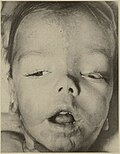Schimmelpenning syndrome: Difference between revisions
CSV import |
CSV import |
||
| Line 29: | Line 29: | ||
{{stub}} | {{stub}} | ||
<gallery> | |||
File:Sebaceous Nevi, Linear; Convulsions; and Mental Retardation 5.jpg|Schimmelpenning syndrome | |||
</gallery> | |||
Revision as of 01:34, 20 February 2025
Schimmelpenning Syndrome is a rare, congenital condition characterized by the presence of skin lesions and various systemic abnormalities. The syndrome is also known as Schimmelpenning-Feuerstein-Mims Syndrome, Linear sebaceous nevus syndrome, or Jadassohn nevus phakomatosis.
Symptoms and Signs
The most common symptom of Schimmelpenning Syndrome is the presence of sebaceous nevus, a type of skin lesion that is usually present at birth. These lesions are typically linear, following the lines of Blaschko, and can vary in size. They are often located on the scalp, face, or neck.
In addition to skin lesions, individuals with Schimmelpenning Syndrome may also have various systemic abnormalities. These can include intellectual disability, seizures, and skeletal abnormalities. Eye abnormalities, such as coloboma and strabismus, may also be present.
Causes
Schimmelpenning Syndrome is caused by mutations in the HRAS gene. This gene provides instructions for making a protein that helps control cell growth and division. Mutations in the HRAS gene lead to the production of an HRAS protein that is permanently active, which can lead to uncontrolled cell growth and division.
Diagnosis
The diagnosis of Schimmelpenning Syndrome is typically based on the presence of characteristic skin lesions and systemic abnormalities. Genetic testing can confirm the diagnosis.
Treatment
There is currently no cure for Schimmelpenning Syndrome. Treatment is symptomatic and supportive, and may include surgery to remove skin lesions, medication to control seizures, and special education services for those with intellectual disability.



